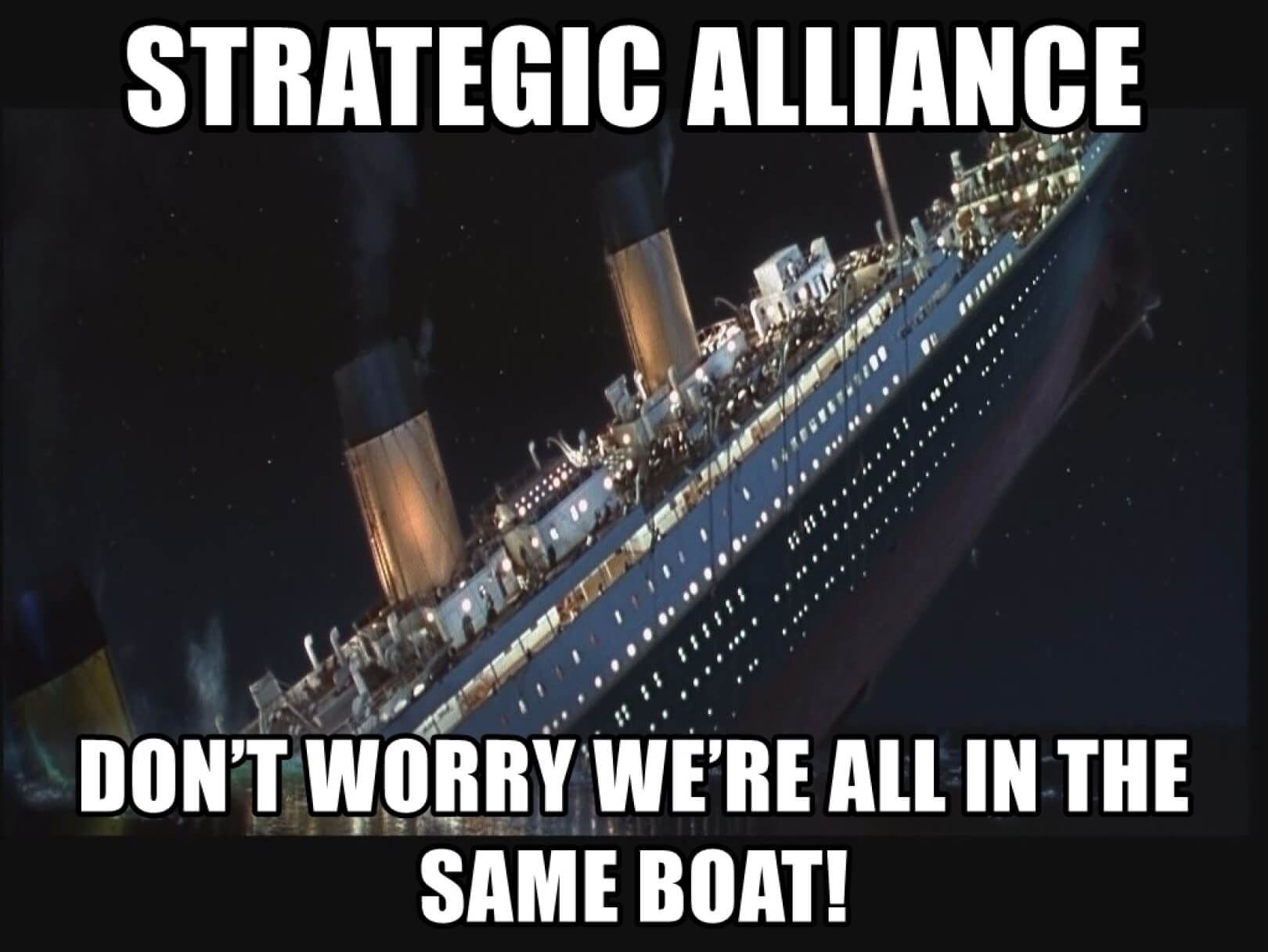Has your company ever collaborated with another organization on a project?
Was it productive? Did your revenue grow?
Strategic partnerships have been around ever since the dawn of enterprises. In recent years, they’ve become even more prominent, to the point where 57% of companies admit they use partnerships to acquire new customers and achieve their business goals.
These types of relationships are mutually beneficial, and ensure the growth of both parties at a reduced cost.
They also present a way to expand your business reach to new markets, try out new strategies, and find new ways to improve performance.
The tricky part is that, in order to develop and maintain a successful strategic partnership, you need to approach it the right way.
In this article, we’ll cover the specifics of how to do that, and more.
Carry on reading.
What Are Strategic Partnerships?
In simple terms, a strategic partnership is when one company or business collaborates and shares resources with another business with the purpose of achieving mutual success and business growth.
These are, typically, long-term commitments with predefined goals. The two sides are non-competing businesses that can provide services or products which benefit their partner/s.
Keep in mind that the partnering companies do not merge into one, they remain independent, but share the benefits and drawbacks of their joint ventures.
One of the first things to do when you find a suitable partner, is to write a strategic partnership agreement. This helps to clearly define the terms of the collaboration and the requirements of the businesses, such as:
- Services performed by each side
- Obligations for each partner
- Duration of the agreement
- Terms & Conditions: profit percentage, billing methods, etc.
- Purpose of the partnership agreement
- Reporting structure, hierarchy, etc.
- Signatures of both parties
Why to Consider Forming Strategic Partnerships?
There are multiple factors and reasons why companies develop strategic alliances. Some aim to increase sales, others to recruit employees. Innovation and new ideas are also a popular reason behind partnerships.
The Benefits of Being in a Strategic Partnership

Here are some of the most prominent benefits of being in a strategic partnership.
- Decreased expenses. You can outsource the sales of a product or service you offer to a partnering company, and take advantage of their sales department. This reduces the costs of hiring and training your own representatives.
- Expanded resources and expertise. Use the strengths of your business partners; e.g. working with a marketing company to expand and reach new markets and/or shorten your sales cycle.
- Boosted sales/revenue. Small businesses, in particular, can benefit from partnering with third-party organizations to reach new audiences. Naturally, extending their visibility can result in a boost in sales.
- Predictable revenue streams. Why rely on estimates and guesses, when you can have predictable revenue streams? Being connected to suitable business partners allows you to outline and plan your income. For example, if you have an affiliate partnership, you can calculate percentages based on expected clicks.
Strategic Partnerships Based on Product Life-Cycles
There are a myriad of reasons for forming strategic alliances. It may be innovation that you’re looking for, or, perhaps automation, reaching new markets, or something else.
However, these reasons, more often than not, have their roots deeply-seated into the types of product life-cycles at the company:
- Slow cycle. In this type of product cycle, companies can afford to not release new products during long periods of time. This is because they have a competitive advantage that allows them time to develop and plan. Pharmaceutical companies are a good example, as their patents last a long time. In practice, the reasons why pharmaceutical companies form strategic alliances include penetrating new markets, and sustaining market stability.
- Standard cycle. In a standard cycle, companies launch new products every few years. The companies are in a dynamic state, where they’re fighting to maintain their position in the industry. Such businesses seek partnerships, in order to gain access to resources, force competitors out, or obtain market share. Think of soft drink companies such as Coca-Cola and Pepsi.
- Fast cycle. Businesses operating in a fast cycle need constant updates and development, because of the high market demand. New products and services are crucial for the survival of these companies, hence establishing alliances to enhance their productivity, share research & development (R&D) expenses, and reach new markets. Software companies are usually involved in this type of product cycle.
Related article: What You Need to Know About Long Sales Cycles
Types of Strategic Alliances
Strategic alliances can be divided into six major categories. Each serves a specific purpose, that depends on the needs of your organization.
For example, small businesses may be looking to work with marketing agencies, and tech companies could be interested in partnering with a supply organization.
Let’s take a look at the types of strategic alliances and what goals they facilitate:
Marketing Partnership
Marketing is a crucial aspect of every business, be it a startup or a big corporation. Strategic marketing relationships, also known as co-marketing, are very common, as a lot of companies don’t have their own marketing departments, or they’re too small to reach their goals.
In this type of partnership, typically, a company refers customers to their partnering organizations and is entitled to a percentage of the profit from these deals.
For example, in 2017, the platform Flipboard partnered with Airbnb. Flipboard featured stories about Airbnb experiences on their site, and customers who viewed and “hearted” them were automatically eligible to win a free Airbnb trip.
This resulted in many new users for Flipboard, and Airbnb gained additional exposure.
Technology Partnership
The world is revolving around technology, and it’s almost guaranteed that you’ll need help with the technical aspects of your business at some point. You may need to use the services of a specialized company such as a hardware maintenance company, a web development agency, or a cloud storage provider.
In all cases, building a technological partnership can and will be beneficial for your business, provided you don’t have your own, in-house tech support.
In return, tech companies could need provisions or services they don’t offer themselves. A good way to approach partnerships with a tech company is to find out how your alliance could be mutually beneficial before reaching out.
Financial Partnership
Another very common strategic partnership is the financial one. A large portion of businesses do not have their own financial departments, thus it only makes sense to become close with a professional agency.
The expertise and insights a financial partner could bring to your business are extremely beneficial, even more so if you can’t afford to hire and onboard an in-house team.
Another example of financial partnership is one of mutual benefit. Let’s say you’re developing software for a bank, and you provide your employees with avails for opening accounts with the bank you’ve partnered with.
Supply Partnership
This is a prevalent strategic partnership model, as every business requires materials, resources, or services of some kind. These could be office supplies like paper, water, or vending machines.
A famous example is the partnership between Coca-Cola and McDonald’s. The soft drink giant is the fast food’s biggest supplier, and the latter is the largest customer of Coca-Cola.
This alliance is extremely mutually beneficial.
Supply Chain Partnership
In this type of partnership, multiple companies use each-other’s services and work together to create a finished product.
Let’s take automobile manufacturing as an example. Sometimes, it’s cheaper to buy parts from another company, making this a valid reason to enter a strategic partnership.
Other examples of a supply chain partnerships are: farmers who produce their own goods, but use external transportation or vending partners to sell these goods; packaging and transportation companies, who take finished products from their partners and then package and deliver them to stores, etc.
Integration Partnership
The main goal of an integration partnership is to create a unique and extremely easy way of using your products. Think of online stores that regularly integrate payment options to satisfy user demand and allow easy purchasing.
In 2017, TripAdvisor and Deliveroo partnered, offering users the ability to order a meal from their favorite restaurants featured on TripAdvisor, using Deliveroo. Another famous example of integration partnership is the one between Amazon and IMDB.
Amazon purchased the online movie platform in 1998, and to date, continues to offer DVD’s and Amazon Prime products to its visitors.
Legal Strategic Partnerships
Legal strategic partnerships occur when two companies combine resources to achieve their goals. Even though both entities are bound through a legal agreement, they remain independent and can grow and expand on their own.
Let’s overview the three main types of legal strategic alliances:
Joint Venture
When two or more companies form a subsidiary (child) company, this is considered a joint venture. Joint ventures are two types: 50/50, and majority owned.
In the first case, both parent companies hold an equal portion of the child company.
In majority owned ventures, one of the parent companies holds more than 50% – 60, 70, etc., leaving the remaining shares to their partner – 20, 30, etc.
Example: Uber and Volvo started a joint venture with the aim of producing driverless cars. The ownership ratio was 50/50, and the business worth was $350 million.
Equity Strategic Alliance
For this type of alliance to happen, one company must own a specific equity percentage in another business. This is considered a partial acquisition. It’s also possible that both businesses purchase equities from one another (cross-equity transactions).
Example: Walmart acquired a majority stake in India’s eCommerce giants Flipkart for $16 million.
Non-Equity Strategic Alliance
A non-equity alliance forms when two companies agree to share resources without sharing equity or creating a subsidiary company. This type of partnership is less engaging and more formal, and, as such, forms the majority of business partnerships.
Example: Barnes & Noble and Starbucks created an alliance back in 1993, allowing Starbucks to have in-house coffee shops. As a result, B&N customers have the opportunity to enjoy their favorite coffee and books together.
Tips on Establishing a Strategic Partnership
We’ve already discussed a lot of details regarding partnerships, but perhaps you’re still worried about how exactly to approach and establish strategic partnerships.
Fret not, we’ve got you covered.

- Mutual benefits. Outline what your business can offer and what you need that other companies could offer. This way, you can obtain a clear understanding of the preferred type of partner you’re looking for.
- No limitations. Don’t limit yourself to what you already know. A lot of times, the perfect partner for your business is within an industry that’s quite different from yours. That doesn’t mean they don’t have something unique to offer.
- Shared objectives. If you want your partnership to succeed, it’s important that you establish and align shared objectives. Carefully assess whether the company culture and values align with those of your potential partners. This will ensure your relationship is built upon a solid foundation and can cope with any challenges that may arise.
- Follow the goals. Partnerships are bound by contracts, and it’s important to follow through on what’s stipulated.
However, when and if things don’t go according to plan, and as there are variables and unpredictable events that could happen, it’s essential to have good communication and understanding of your goals. This helps to overcome whatever obstacles may come your way. Be flexible, and update the contract, if needed.
Good Examples of Strategic Partnerships
To gain an even better understanding of the strategic partnership model, let’s take a closer look at a few good examples:
Walt Disney and HP
Disney oversaw the rise of technology. They knew they would need the help of a tech giant, in order to satisfy their customer’s demands, and here’s where HP stepped in.
To this day, Disney still uses HP platforms in their animations, rides, and enhanced customer experience.
In return, Disney brings aboard their reputation, which is a synonym for success. Together, both brands venture into new markets, and establish an unparalleled user experience.
GoPro and Red Bull
Back in 2012, Red Bull sponsored Felix Baumgartner’s record-breaking skydive, while GoPro provided the camera that captured the footage.
That was the beginning of the partnership between the brands, which later on developed into a long-term strategic alliance.
Red Bull & GoPro collaborate on extreme sports events, which makes sense as both brands have similar audiences.
BMW and Louis Vuitton
These huge organizations don’t seem to have much in common at first glance. One produces automobiles, and the other is a fashion house.
However, if you think about it, both sell luxurious items, meaning they have a similar audience. So they partnered to create a unique set of Louis Vuitton bags to pair with the BMW i8 sports car.
The result?
Both brands enjoyed an increase in exposure, and benefited from the collaboration.
Challenges for Creating Strategic Partnerships
Naturally, there are a lot of challenges ahead when creating lasting business partnerships. Let’s analyze some of the most common ones and how to resolve them.
Management Styles
Different managers have different management styles. Some are goals-driven and task-oriented, while others are more relaxed and prefer a “calmer” company culture. This could create organizational issues, especially if both managers have a similar style: imagine both use a relaxed approach and don’t worry too much. This could possibly leave the company without a leader that “pushes” work and drives projects forward.
Fix: Make sure to align managerial styles and plan ahead who’s responsible for what. This way, you won’t have to be overly organized, nor overrun with ideas, without anyone to execute them.
Equity and Evaluation
As mentioned, not every business alliance is split 50/50. A lot of times, one company owns 80% of the business, which raises questions about the role and evaluation of their partner. This is why it’s necessary for joint ventures and partnerships to create a strategic plan, and be clear on their roles.
Fix: Address questions and uncertainties at the end of each courting period. Make partner statuses crystal clear and eliminate tension.
Different Personalities
Everyone has their own working habits – some are workaholics who spend extra time in the office, while others prefer a more balanced work-life cycle. It’s important to keep an open mind, since not everyone follows the same piper.
Fix: It depends on the person and case, so approach everyone individually. Don’t be too critical or demanding – you don’t want to cause your partner to burn out, or drive them away.
Don’t Take It Personally
There’s a chance you befriend your business partner and grow close during the course of your collaboration. This shouldn’t interfere with your business decisions and strategies. In fact, any disagreements shouldn’t be taken personally, as they are not about your friendship, they’re purely business.
Fix: Differentiate business from personal matters. Focus on what you know about your business partner’s weaknesses and strengths, and keep a unified vision.
Summary
Strategic partnerships play an important role in the success of your business. They’re not always easy to develop and maintain, but nothing good in life ever comes without overcoming a few obstacles.
If you want to be successful, make sure to align your strategic partnership, set mutual goals, outline responsibilities and distribute shared resources.
Before approaching a potential business partner, always ask yourself: what value can be added and at what cost. Planning and research are the key to building a mutually beneficial and prosperous strategic alliance.
Now:
Let’s plan, execute, and take our business to the next level.





